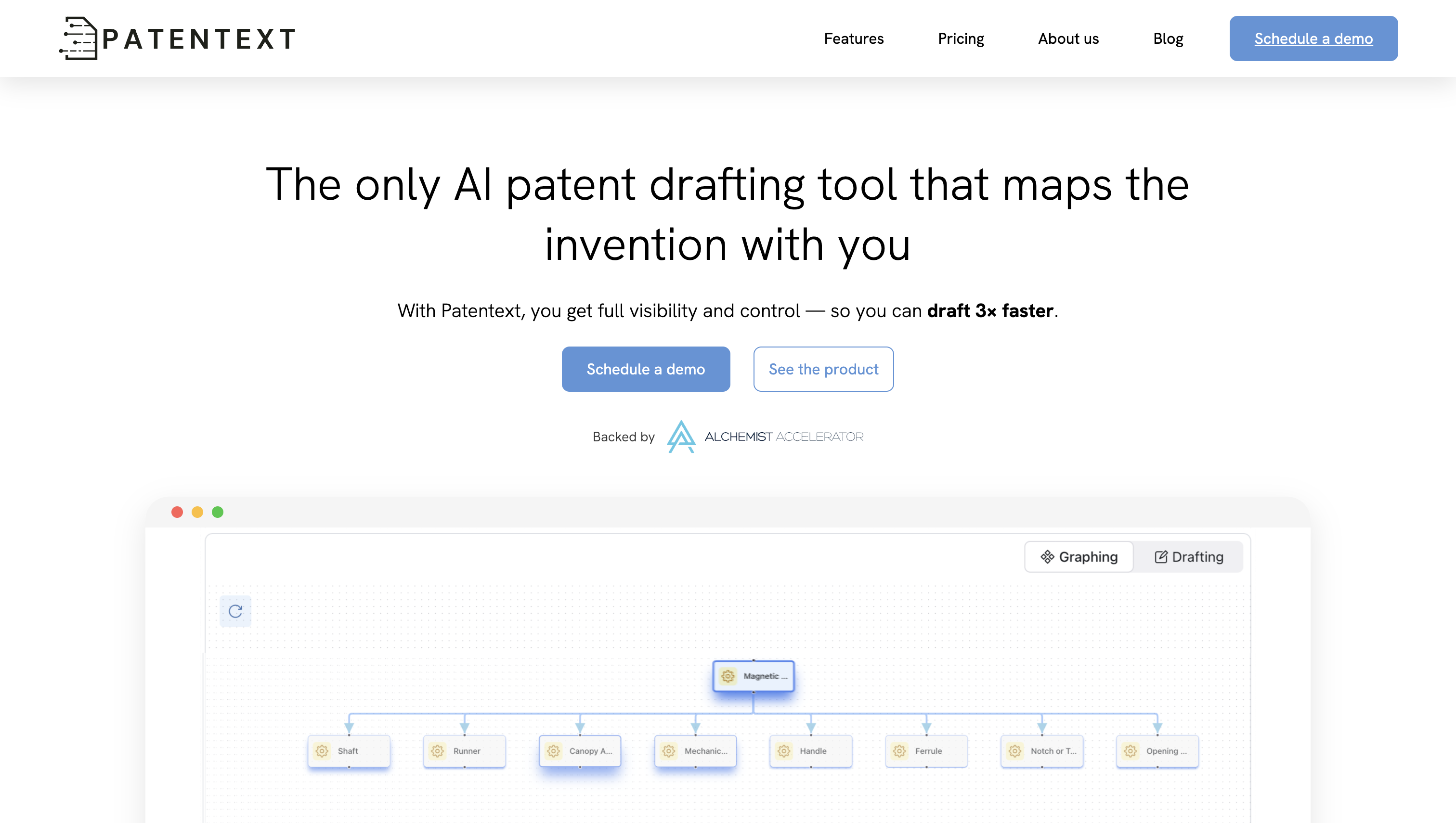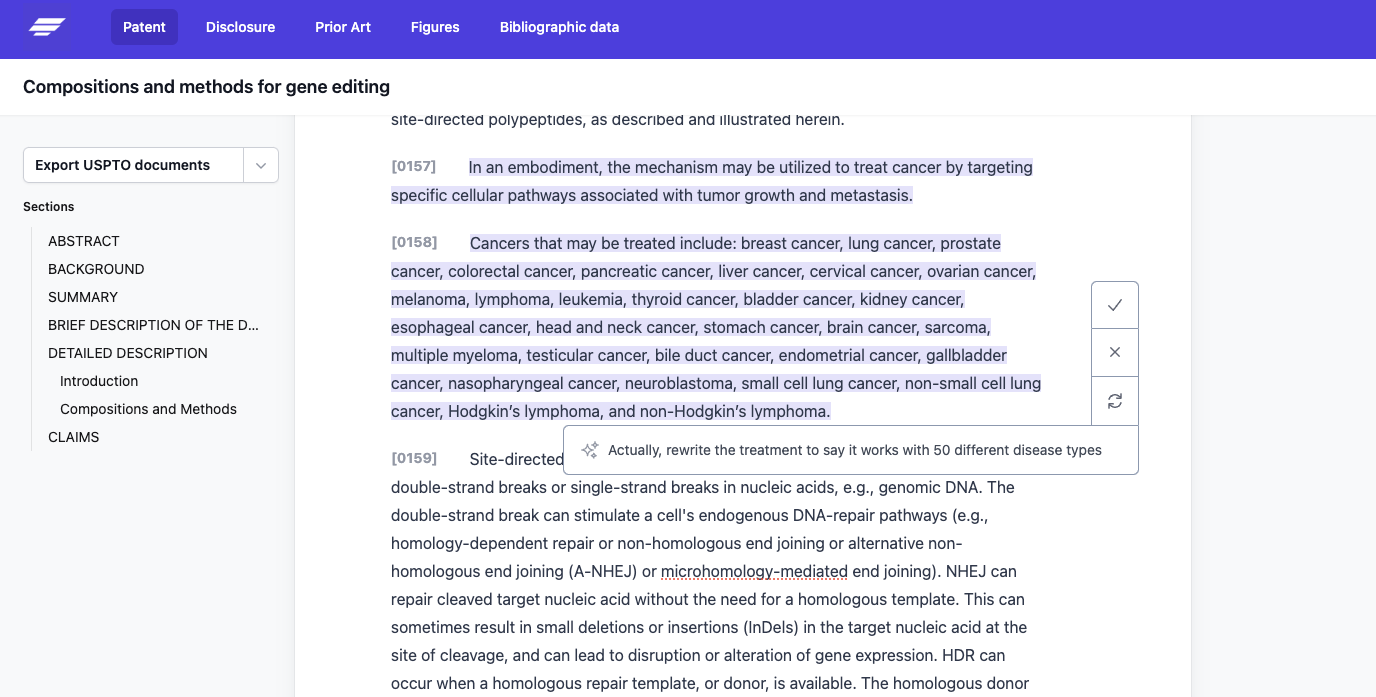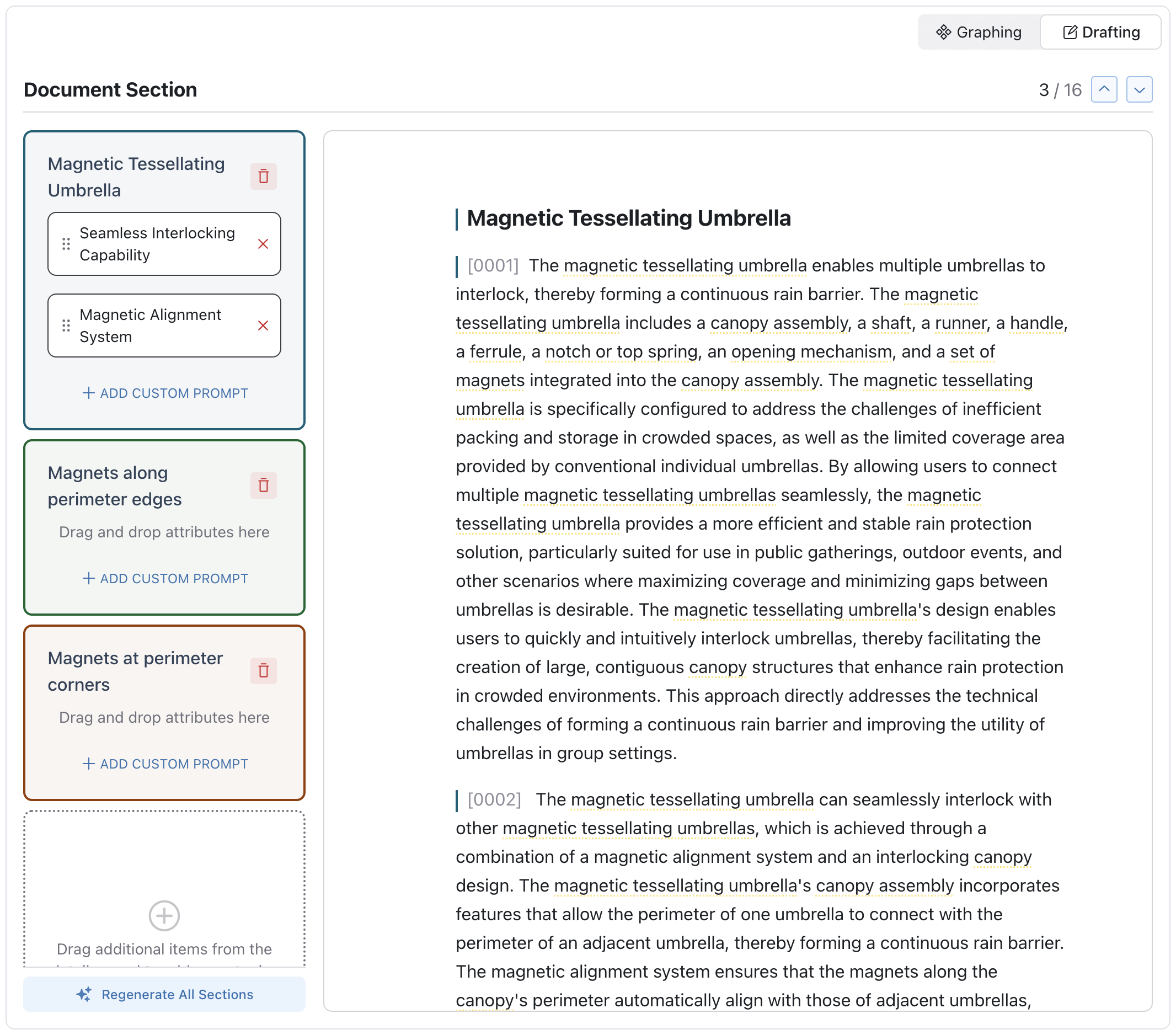subdirectory_arrow_right
If you’re evaluating AI tools for patent drafting, there’s a good chance Edge is on your radar. It’s built up a sleek brand and a loyal following, especially among solo patent practitioners and small firms looking to move faster.
But it’s not always clear how Edge actually works or how it compares to other tools solving similar problems in different ways. For teams exploring alternatives, it helps to understand what a more structured approach might look like.
One of those tools is Patentext. Launched in early 2025, it’s a different kind of patent drafting platform: one that focuses less on executing isolated tasks and more on building logically consistent applications from the ground up.
This breakdown covers what both platforms do well, where they diverge, and how to decide which one fits your drafting workflow best.
Edge vs. Patentext: quick overview
What is Edge?

Edge is an AI-powered copilot for patent drafting, designed to accelerate tasks like claim generation, spec writing, and invention disclosure intake. It promises to cut hours-long work down to minutes, with an interface built to feel more like a modern productivity tool than traditional legal software.
The company was founded by Evan Zimmerman and Len Boyette, who met through Y Combinator. Zimmerman, the CEO, holds a JD from UC Berkeley and previously led a venture firm with a focus on IP strategy and early-stage startups. Boyette, the CTO, comes from a technical background and has previously built consumer-facing software.
While neither founder comes from a patent prosecution background, Edge has quickly gained visibility thanks to its fast, task-based drafting tools and polished UX. The tool doesn’t aim to replace the entire patent workflow, but rather to augment it by speeding up specific parts of the process.
What is Patentext?

Patentext is an AI drafting platform built around a structured, visual approach to patent applications. Rather than starting from a blank page or relying on open-ended prompts, it guides the process using a graph-based editor that maps out the invention. That structured input becomes the backbone for generating each section of the application.
Launched in early 2025, Patentext is the result of over ten years of direct patent drafting experience. The team behind it has worked across the spectrum, from large firms like Fenwick & West to nimble boutique agencies, supporting everyone from first-time founders to unicorns like Facebook and Airbnb.
That background has shaped Patentext’s core philosophy: faster drafting shouldn’t come at the expense of clarity, structure, or consistency.
Edge vs. Patentext: How they work
Edge: Task-based copilot

Edge takes a task-based approach to patent drafting. Rather than relying on open-ended chat or document uploads, the tool lives in a cloud-based editor where users trigger specific drafting actions using keyboard commands or in-line prompts.
Pressing Command‑K, for example, brings up a menu of options: generate an independent claim, expand an embodiment, edit a lead line, or structure inventor input into a disclosure.
Overall, Edge is less about “talking” to the AI and more about executing discrete actions, making it feel more like a modern productivity tool than a conversational assistant. For users who prefer click-and-go functionality over prompt engineering, that design can offer speed and predictability.
Patentext: Graph-driven drafting

Patentext approaches drafting from a different angle. Instead of relying on prompts or document overlays, it starts by turning a raw disclosure — like notes, transcripts, or technical papers — into a visual graph that breaks down the invention’s key steps, features, and their relationships.
That graph serves a dual purpose. It gives the user a clear, editable structure that reflects the logic of the invention, and it provides the AI with a precise, structured context from which to generate. Rather than trying to infer meaning or guess at organization, the model builds each section of the application directly from the graph, making the output more consistent, auditable, and easy to revise.
Edge vs. Patentext: Draft quality and output consistency
Edge
Edge users generally find that the tool excels at well-defined, granular tasks. Generating dependent claims, fleshing out figure descriptions, or turning inventor notes into disclosures tends to yield clean, usable content. The interface supports a preview-and-tweak workflow, which helps limit off-target outputs.
However, longer or more interconnected drafting sections are where limitations surface. Because the user must generate each part independently using task-specific prompts, there isn’t a built-in mechanism to ensure that terminology, tone, and structure flow uniformly through the document. This means there can be inconsistencies between claims, spec language, and figures when viewed as a whole.
Patentext
Patentext takes a structure-first approach to draft generation. Because every section (e.g., claims, spec, abstract) is generated from the same underlying invention graph, the platform naturally reinforces consistency. Once a component is defined in the graph, the same description carries through across the application, helping reduce mismatched terms or shifting definitions.
That said, the platform currently prioritizes logical alignment over stylistic control. While the output is typically clean and coherent, it doesn’t yet capture personal drafting voice or firm-specific phrasing. Features for customizing tone and language are in development, but not yet live.
Edge vs. Patentext: user experience and onboarding
Edge
Edge delivers a fast, modern editing environment that mirrors tools like Notion or Linear. The workspace features auto‑save, version history, and branching, supporting iterative drafting and experimentation. Most users find the UI clean, responsive, and fast for targeted tasks.
However, because Edge’s AI processes remain behind the scenes with no visible prompt templates, context graphs, or draft ancestry, new users may find the tool’s logic opaque.
Patentext
Where Edge emphasizes speed and open-ended exploration, Patentext offers a more structured and guided experience. From the moment a disclosure is uploaded, the platform walks users through a defined workflow, mapping out the invention in a visual graph that becomes the foundation for the draft.
Unlike Edge, which relies on task-triggered commands and command memorization; instead, users build out their application by editing nodes, defining relationships, and reviewing AI-generated sections tied directly to the invention structure.
This clarity makes onboarding more predictable, especially for practitioners who think in terms of claim logic and functional breakdowns rather than typing instructions into a chat-box. Each part of the interface is purpose-built for patent work, and the flow encourages a deliberate, repeatable drafting process.
That said, the approach can feel unfamiliar at first, particularly for users expecting a blank document or conversational interface. Terms like “component,” “attribute,” or “node” may take a session or two to get used to, and the graph-based model introduces a different mental model than traditional word processors.
Still, for teams that value structure, traceability, and a transparent view into how the draft is built, that learning curve often pays off. The system makes it easier to spot inconsistencies, track logic, and scale a consistent drafting style across a team.
Edge vs. Patentext: collaboration and review
Edge
Edge leans heavily toward solo drafting, with collaboration features limited compared to team-focused tools.
While it includes version control (specifically tracking changes and enabling branching), it doesn’t support real-time co-editing, in-app commenting, or user roles for reviewers. Drafts are tied to individual accounts, and the primary mode of feedback sharing is still via exports or screenshots, rather than integrated review workflows.
Patentext

Unlike Edge, which is built primarily for solo use, Patentext includes several features designed with team collaboration in mind. Each team member has access to their own invention graphs, and organization admins can view and manage all drafts across the account. This creates a shared workspace where multiple contributors can stay aligned without stepping on each other’s toes.
What makes review particularly efficient in Patentext is the structure behind the draft. Every paragraph ties back to a specific node in the invention graph, so reviewers can see exactly where the generated content came from and what it’s meant to describe. That context helps reduce confusion during handoffs and makes feedback more actionable, even when edits are happening asynchronously.
While full multi-user editing and in-line commenting aren’t live yet, they’re on the roadmap. The goal is to extend collaboration directly into the graph model, bringing shared editing, context-aware comments, and invention-structured version histories into the drafting flow.
Edge vs. Patentext: additional features
Edge
While Edge is primarily known for speeding up drafting tasks, it includes a few notable features that go beyond basic claim or spec generation:
- Figure editing tools: Edge includes an integrated figure editor that allows users to generate flowcharts from text, edit lead lines, and maintain alignment between figures and the written spec.
- Jurisdictional tailoring: The platform supports basic regional customization for filings (e.g., USPTO vs. EPO), helping users stay aligned with jurisdiction-specific norms for formatting and structure.
- Template customization: While Edge doesn’t expose its prompt logic, users can apply firm-specific templates to standardize outputs across claims, specifications, and other sections, which is useful for maintaining consistency without manual formatting.
Patentext
As mentioned, one area where Patentext stands out is in how it handles consistency across the entire draft. Its recently launched References feature is designed to eliminate the manual, error-prone work that comes with maintaining alignment between terminology, figure numbers, and application text.
Instead of updating terms section by section, users can:
- Define aliases for nodes and apply consistent terminology across the full draft
- Assign figure reference numbers that auto-update wherever they’re used
- Click any reference to jump directly to the related node in the invention graph
This creates a tight feedback loop between structure and language, particularly useful when terms evolve late in the drafting process or when multiple team members are involved.
Edge vs. Patentext: pricing
Edge: Enterprise-first pricing
Edge doesn’t list pricing on its website. Instead, you need to book a demo with sales to discuss options. This custom approach may work well for larger organizations with complex needs, but it can be a hurdle for solo practitioners or smaller firms trying to quickly evaluate cost without a sales conversation.
Patentext: Boutique firm-friendly pricing
Patentext offers early access, volume-based pricing that starts at $200/draft, which includes full use of the whole platform. There are no seat minimums, setup fees, or lengthy onboarding, making it an easy lift for solo agents, boutique firms, and lean patent teams to start drafting right away.
That said, this early pricing won’t last forever, so if you’re considering trying it out, now’s the time to lock in access before the full public launch.
Edge vs. Patentext: use cases
Edge: Best for fast-moving solo drafters and lean patent teams
Edge works best for experienced solo practitioners, small firms, or in-house teams that already know what they want to say and just need a productivity boost to move faster through familiar drafting tasks. It’s fast, responsive, and well-suited to generating content in small chunks — claims, figure descriptions, short spec sections — when the direction is already clear.
But it’s not built for end-to-end drafting or collaborative workflows. There’s no unified structure connecting the sections it generates, and because it lacks full-document output, consistency and flow are left up to the drafter.
In practice, that often means exporting fragments from Edge and piecing them together manually in Word, prompt by prompt, section by section. For teams looking for a repeatable, auditable process, or simply trying to avoid that stitching overhead, the gaps can add up.
Patentext: Best for solo agents and boutique firms
While Edge appeals to fast-moving drafters looking to speed up specific tasks, Patentext is built for those who want a more structured, repeatable drafting process without giving up control or clarity.
It’s particularly well-suited for:
- Solo agents and attorneys who prefer a systematic workflow that saves time without relying on chat prompts or ad hoc generation
- Boutique firms that prioritize consistent, high-quality output across their team and want a clear way to review and refine drafts
- Practitioners who don’t want to prompt-engineer or guess what the AI needs — Patentext’s graph-driven model means the logic is explicit and editable from the start
- Teams that care about traceability, whether for QA, internal training, or client transparency
Final verdict: Which should you choose?
Edge and Patentext are both tackling the same core challenge: using AI to make patent drafting faster and less painful. But they approach that problem from very different angles.
Edge treats drafting as a series of discrete actions. Its strength lies in speed and flexibility — generating small pieces of content quickly, with minimal friction. For experienced drafters who already know the structure they want, it can be a useful accelerator. However, it also leaves the burden of consistency, cohesion, and review on the user.
Patentext, by contrast, starts with structure. Its graph-based approach gives the AI a clear blueprint of the invention from the beginning, which makes the resulting draft more aligned, auditable, and consistent. That structure may take an extra minute to set up, but it reduces the time spent stitching, second-guessing, and revising later.
In short:
- Choose Edge if you want a fast, modular drafting assistant and are comfortable managing structure on your own.
- Choose Patentext if you want an end-to-end platform that builds consistency into the process from the start.
Curious how Patentext fits into your workflow? Schedule a walkthrough with your own disclosure.
Disclaimer: This article is for informational purposes only and does not constitute legal advice. Patent laws are complex and vary by jurisdiction. For personalized guidance, consult a qualified patent attorney or agent.
.svg)
